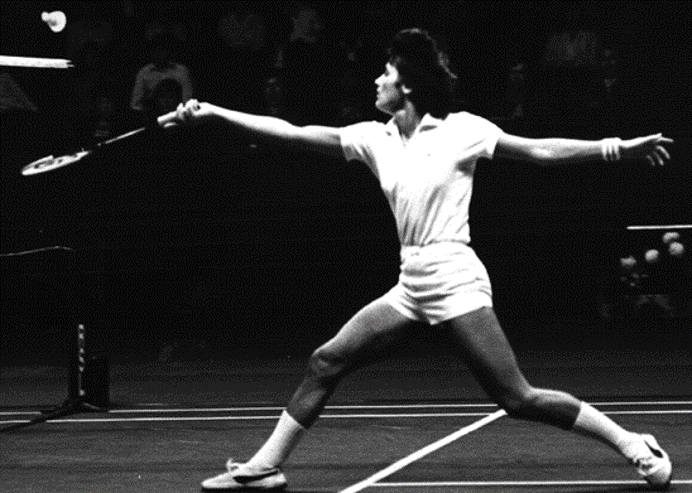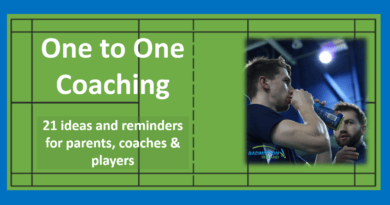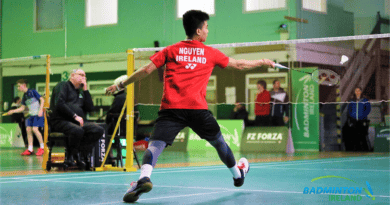What are the Badminton Playing (Technical) Basics : Part 3 of 4
Part 3 : Encourage quick starts and preparation for ‘Power’
This article is based on work done by Roger Mills a professional badminton coach and my friend
This is the 3rd of the 4 posts that look at the Playing Badminton Basics. I hope you enjoyed Part 1 and Part 2
Have you had time to try out ideas with your players? Your challenge is to create these underpinning/foundation skills without naming the Badminton Strokes. It would be great to hear what happened on your court and if you are seeing changes. The underpinning playing badminton basics is something that excites me.
A quick reminder, if you haven’t read Parts 1 or 2 then please don’t expect a list of strokes
The Playing Basics aren’t names strokes such as High Serve, Smash, etc. They try to state the components of hitting and moving skills ie parts of strokes and movements.
Some of the Playing Basic can be observed in many different areas and strokes on the court. Others are both Technical and Tactical. It’s up to you to decide.
I would recommend that you focus on these components as they certainly affect the larger more complex strokes and movements.
– – – – – – – – – – – – – – – – – –
Playing Basics 5 – 7
5 Pretension in starting and moving
6 Categories of 4 main hitting actions
7 Legs and arms wide for balanced movements
– – – – – – – – – – – – – – – –
5. Pretension in Starting & Moving, plus Power Strokes
Finding a way to cause your muscles to stretch in preparation for movements and strokes is an essential technique. It’s a Playing Basic because, without this pre-stretch, reactive movements will be slower and some power strokes not quite as powerful. The question for you now is to try and identify where and when it happens. Then can you allow and encourage it through simple and easy development work?
Movements
 Almost before every shot is struck by the opponent there will be a pretension movement into a wide “ready to move” stance. This quick start stance will vary (see later articles on Stances). The timing is vital “Land as the shuttle is struck” and “Pretension wide !”
Almost before every shot is struck by the opponent there will be a pretension movement into a wide “ready to move” stance. This quick start stance will vary (see later articles on Stances). The timing is vital “Land as the shuttle is struck” and “Pretension wide !”
The stances are different if the shuttle is above or below the tape (to of the net) on the opponents’ side. The stance and leg pretension are combined together and are timed to happen just before the opponent is about to strike the shuttle.
However, this pretension timing does not just apply to being in a semi- stationary stance.
Often the player will move quickly from one court position to another without “waiting” and will use a timed pretension loading movement (again landing as the shuttle is struck) to give a quick movement.
There has been some debate over the ‘height’ of the initial movement as can been seen in the photographs here. My thoughts nowadays are that the height is unimportant, it’s the timing of the movement and landing that matters.
I’ve seen World Class players with very small jumps that look more like just a bending of the legs and others who seem to leave the court by at least 12 cm. What is important is the width of the landing and the timing, in fact, the timing is VERY important.
Coaches …..how do you encourage & develop this timing so that the anticipatory movement results in a powerful initial movement, even if its different to the anticipated one?

Strokes
Pre-loading of your muscles is also important for producing power. It’s also important at times to look like you are about to produce power, so this pre-loading will also aid deception.
Within complex strokes such as the overhead forehand smash and high backhand clear, pre-loading of muscle groups is vital. The timing and sequences of these actions need to be smooth with no stutters or stops within the action.
The coach should be able to see this smooth progression and the players report that it ‘feels as if the power just flows’.
What shapes are required for the body to pre-load in these strokes ; the deep forehand, the jump smash, the overhead high backhand.
Close your eyes and tell me what you see that could be described as pre-loading for ‘Power’

– – – – – – – – – – – – – – – –
6. Categories of Hitting Actions
We can say that most strokes fit into 4 main hitting actions.
They are descriptive only, and are to be used in the teaching of specific strokes. It is generally accepted that the following words clearly describe these actions – PUSHING , FLICKING , THROWING , TAPPING.
Throwing : Overhead forehand strokes such as the clear and smash. Deep forehand
Pushing : Defensive blocks, fast net shots, deep backhands, deep forehands
Tapping : Net kills, overhead backhands, crosscourt blocks
Flicking : quick upward strokes often at the net or in the midcourt
If you are familiar with these hitting actions then I would be interested in how you incorporate them into the sessions for players aged 7- 9 years old
Warning
Be careful not to allow small, young players to use forehand underarm throwing actions rather than flicking.
In an attempt to hit with power they may ‘throw underarm’ rather than flick from in front of themselves. This can become a habit that is very difficult to change.
I recommend the use of ‘Wallwork’ in early developmental practices. This will encourage many of the playing basics and hopefully reduce the tendency for players to want to ‘throw underarm’
The signs to look out for
.. an elbow close to the body part way through the throw
.. not striking from in front of themselves
.. often plenty of power but with flattish trajectories. The shuttle often travels flatter and not hit upwards.
– – – – – – – – – – – – – – – –
7. Legs and Arms Wide for balanced movements
Generally, all court movements should be performed with the legs wide apart. Wider than shoulder width. Use is made of both arms for balance, the non-hitting arm acting as a “timed” counter balance for the racket arm. Coaches can instil into the developmental sessions the phrase “legs WIDE, arms WIDE”
Legs Wide
 When I was introduced to this concept as a playing badminton basic it took a while to appreciate the benefit. Especially how important it was to ensure that players become comfortable in having ‘legs wide’. The constant changes in direction requires a lower centre of gravity with knees bent, not just legs wide.
When I was introduced to this concept as a playing badminton basic it took a while to appreciate the benefit. Especially how important it was to ensure that players become comfortable in having ‘legs wide’. The constant changes in direction requires a lower centre of gravity with knees bent, not just legs wide.
Please be aware that we should not expect all players to move around the court with wide legs for all movements.
Yes, some players (often male) with well developed length strength can easily move whilst keeping their legs apart in a chasse like movement. However, the aspect of running is also an essential movement skill.
Legs wide applies to most players in aspects such as defensive stances, forward movements and lunges towards the net. It can also often be seen in the Deep Forehand when the shuttle is slightly above and behind the player.
- Encourage players to feel comfortable even when they are in slightly uncomfortable positions
- The aim is not to have perfectly balanced movement
- The goal should be getting the shuttle over and placing the opponent in difficult tactical, mental and physical positions
- Matches and important points can be won without playing perfect badminton
Arms Wide

 Having Arms Wide, especially in wide-lunging situations is important for balance.
Having Arms Wide, especially in wide-lunging situations is important for balance.
Thinking about ‘counterbalance’ is probably a better way of thinking about Badminton movements. Often the game will be played in a state of ‘controlled imbalance‘ and to seek perfect balance is not a desirable aim.
I often exaggerate this Playing Basic when working with players as it’s quite difficult to have arms as wide as in these photographs.
Start using this image in very early practices such as bouncing the shuttle or balloons on the racket. It is also easy to instil this during net shot practices when moving forward.
The aspect of arms wide is not seen everywhere on court.
During the ‘afterstroke’ in forward overhead strokes and the Deep Forehand the arms will be crossed across the body in another counter balance movement.
– – – – – – – – – – – – – – – –
As always, I’m very grateful if you have read this far 🙂
I hope you enjoy the questions. Is there anything that you’ve read that has helped or you disagree with then please send me an email.
I’d love to hear your views contact@badmintonandy.com
– – – – – – – – – – – – – – – –
Next Time
In Part 4 we will look at the rest of the Badminton Basics, numbers 8 – 10. I hope you will stay around and be prepared to comment with ideas of your own.
What do you think you will see in Part 4 ?
8 Lunging timing principles
9 Sideways turning just prior to contact with the shuttle
10 Contact at the highest point





